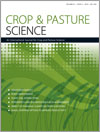Multi-species pastures have been viewed as a means to increase forage production relative to monocultures through enhanced three-dimensional occupation of the canopy, which will intercept and use the incident radiation more efficiently. For this to occur, increased production of photosynthetically active tissues such as leaves is required. We tested the hypothesis that intercropping of black oats (Avena strigosa Schum.) and annual ryegrass (Lolium multiflorum Lam.) can increase total and leaf forage production compared with their monocultures. Monocultures and mixed pastures of black oat and annual ryegrass were established, and their tiller morphogenetic and structural traits, as well as components of herbage production, were measured throughout the usage period of the pastures. There was no difference between treatments for total growth rate (77.1 kg dry matter (DM) ha–1 day–1), but annual ryegrass pastures presented the greatest stem growth rate (38.1 kg DM ha–1 day–1). Taking into account only the vegetative phase, the intercropped pasture produced 20% more leaf than the monocultures. There were no differences between species, either in monoculture or intercropped, for phyllochron, final leaf length, leaf elongation duration and leaf elongation rate. The most important modification in morphogenetic variables due to the inter-specific competition was an increase in senescence rate of annual ryegrass leaves. The average specific green leaf weight in the intercropping pastures corresponded to 84.6% and 137.5% of those values observed for black oat and annual ryegrass pastures, respectively. On the other hand, the intercropping pastures presented 43.5% more tillers than the black oat pastures and 17.8% fewer tillers than the annual ryegrass pastures. It is suggested that intercropping black oat and annual ryegrass does not change tiller ontogenetic processes and that the association of their different size and shape in intercropped pastures could increase pasture leaf production over their monocultures.
How to translate text using browser tools
23 May 2016
Intercropping black oat (Avena strigosa) and annual ryegrass (Lolium multiflorum) can increase pasture leaf production compared with their monocultures
Paulo G. Duchini,
Gabriela C. Guzatti,
Henrique M. N. Ribeiro-Filho,
André F. Sbrissia
ACCESS THE FULL ARTICLE
<
Previous Article
|

Crop and Pasture Science
Vol. 67 • No. 5
May 2016
Vol. 67 • No. 5
May 2016
annual grasses
forage production
leaf production
mixture
morphogenesis
ontogeny




